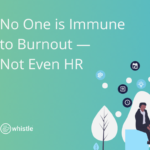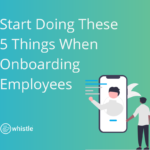Employee Loyalty Leaders
Interviews with HR Leaders Building Exceptional Employee Experiences
Interviews with HR Leaders Building Exceptional Employee Experiences
The more your employees feel connected with your organization and what their contributions are; they will gain a sense of purpose which will result in further engagement.
As companies look ahead, there’s no disputing the pandemic has fundamentally changed the way people work. This shift impacts some industries more than others, but employees of all kinds have different needs that employers will need to address — or risk losing top talent.
In this interview series, we’re talking to HR leaders to get their insights and stories about how companies can improve the employee experience.
Katie Harman has worked in Human Resources for nearly 18 years and currently serves as Vice President Human Resources for COMTREA Health Center, where she focuses on employee culture, engagement, and professional development to support COMTREA’s mission.
In your opinion, what is the most important responsibility of an HR department?
Human Resource departments have the responsibility to model the company’s core values first and foremost. To do this well, HR professionals must embrace a business mindset and provide service/partnership to all employees in order to meet individual employee needs.
With all the information in the news about The Great Resignation, what do you think hiring managers really need to understand?
When it comes to recruitment, hiring managers should consider the applicant’s overall experience. Are they receiving timely feedback about the interview process? How long is the interview process? If it is too long, you’ll likely lose good applicants.
It’s important to evaluate how hiring managers are selling your company. What are the perks/advantages of working at your organization? Be sure to provide managers with the support they need to communicate effectively.
When selecting the right candidate, keep in mind that in today’s labor market, there may be slim picking; therefore, hire for culture and potential development or upskilling if needed.
On the employee retention end, it’s imperative to listen, support, and develop your employees. Help connect your employees to the organization’s purpose and mission. If they feel connected with their organization and what their goals and contributions are; they will gain a sense of purpose which will result in further engagement.
Another important recommendation for HR Leaders is to build strong relationships with your team; not just professionally, but also personally. We all have had several obstacles to overcome with COVID – some more than others. Be empathetic and compassionate during times when your staff are going through hard times, and they will repay you in the long run.
Believe it or not, conversations at the dinner table include you as a leader and the employee’s experience at your organization; are these conversations positive or negative? Don’t underestimate the impact your leadership has on your team.
Have you noticed any trends in employee engagement, and what can companies do if they face productivity challenges?
Think about yourself for a moment… What type of environment makes you perform at your best? Is it when you feel valued? Supported? Heard? How do you feel when barriers are removed? Answer these questions for yourself, and then think about the type of environment you are providing to your employees.
I believe in today’s world, you have to lead based on the level of performance your employees are at within their job. You may have some employees who know their role inside and out, who are highly engaged, and therefore have stellar results. On the other hand, you may have employees who may not be as engaged, may be newer in their role, and may require a little more support, motivation and development. Us as leaders, need to be able to gauge the level of our employees and meet them at their level. Us as leaders, need to be able to gauge the level of our employees and meet them at their level. As leaders, we need to be able to gauge the level of our employees and meet them at their level.
Another aspect is to re-energize your staff to do what they enjoy doing. A lot of people through the time of COVID are experiencing burnout symptoms and truly evaluating what they enjoy doing. As leaders, if you have those strong relationships, you have the opportunity to support your staff in helping them do what brings them joy. Have the conversations; it will enable engagement!
In regards to productivity challenges, I believe the first obstacle is to find out what is causing the productivity challenge in the first place. Is it a system issue, a product issue, a work-flow issue, lack of follow through or accountability, or a management issue? Talk to your employees. Get them to help contribute to the solution and diagnose the issue. The more the employee is able to help diagnose the concern/issue, then they are more apt to help develop a plan of correction and stick to their own recommendation.
You should also look at the human side of the issues that get raised. Is this an employee who in the past was excelling and within the last few months have been declining? If so, do they have anything difficult going on in their personal lives? You can give them grace, compassion, and support to get through the tough times while still holding them accountable to the expectations. They will end up giving you 100% more in the end.
I would also challenge leaders to do step-level conversations to help talk with challenged employees on why their productivity numbers are not being met? Are they unreasonable numbers to begin with? Is their direct leader un-inspiring and not supportive in coaching these staff to improve productivity? There is a lot that could go into this issue — and it’s not always the employee that’s to blame.
What is one thing HR leaders can do differently that will have the biggest positive impact on employee morale?
Listen! So many organizations survey their employees and often don’t follow through with stating that they heard them — and then also including them for solutions.
Listen to your employee’s survey feedback, and conduct stay and exit interviews. If you lead a team, spend time getting to know them both personally and professionally. Celebrate your wins as a team and organization!
What tips or examples do you have on ways companies can show employee appreciation?
We have a WorkWell committee that is comprised of employees at all levels within our organization. They do an awesome job with hosting fun activities such as Bingo, a pet mascot contest, and employee BBQ/food trucks! Our HRIS also has a platform for any employee in the organization to give recognition to any other employee, as aligned to our core values. However, many employees are just looking for a simple “thank you” and recognition of their efforts. A genuine “thank you,” goes a long way!
How important is new employee onboarding, and what tips or guidance would you share that have been successful for you?
This is an area we are currently fine-tuning. There is so much that goes into the onboarding of a new employee — everything from the offer, to the first few days of orientation, to 60-90 days into their position.Getting this experience correct over the first 90 days is key! We have checklists for our hiring leaders to utilize during a 90-day process to help make the best experience for the new employee. This includes being prepared for the new employee on their first day (i.e. having the equipment they need for their job ready, email set up, office location etc.), having team introductions/lunches, and/or assigning some sort of mentor for the new employee to access for questions. We also do a 90-day check-in questionnaire to rate their experience and to help determine any modifications to improve the process.
What are the biggest opportunities and/or pitfalls companies face when it comes to training and development? Any ideal solutions?
Everyone learns differently, which makes one-size-fits-all training programs a challenge. One approach to training will work for some employees but may not be ideal for others. This is especially difficult when you’re working in smaller companies, as they do not have designated support specific to training and development.
Ultimately, it comes down to having open communication with the employee to understand how they best learn and the specific skills they need to develop.
In today’s world with the labor shortage, organizations must focus on up-skilling and developing their current staff for succession planning. It’s also important to have continuous conversations around what their employees are looking for within their future career plans — and how the organization can support those employees to reach those plans.
About COMTREA Health Center
COMTREA is a private, non-profit 501(c)3 organization and Federally Qualified Health Center that provides integrated, comprehensive primary care, dental care, and psychiatric services to the Jefferson County, Missouri area.
Sign up now to receive monthly updates from Whistle including more interviews with HR leaders sharing their thoughts on employee loyalty, culture and experience.

 Start Doing These 5 Things When Onboarding New Employees
Start Doing These 5 Things When Onboarding New Employees